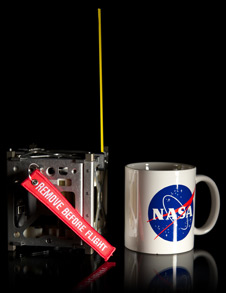For satellites, it used to be that dreams and big visions turned to reality after many years of development and many millions of dollars. This is no longer the case. CubeSats, a miniature-size satellite, offer an interesting paradigm shift that completely changes the design process for satellites, providing a relatively inexpensive access to space. For the traditional, expensive, and large satellites, the design goals often focus on making an extremely robust, high-performance satellite designed to survive and operate for many years. This means that every traditional satellite is likely to be highly customized and engineered for its particular purpose. For CubeSats, however, the big idea is to utilize existing commercial-off-the-shelf (COTS) parts and launch as a secondary payload from another mission. There is currently a CubeSat standard that makes COTS parts cost-effective, and a universal launch platform known as the P-POD (Poly-Picosatellite Orbital Deployer) is used to launch the CubeSats from the primary vehicle. To be a secondary payload, the volume and mass must be extremely small compared to typical satellite installations. Only recently did a small satellite size become a plausible concept as integrated circuits became smaller, more advanced, and more energy conscious. A typical size of a CubeSat is a 10cm x 10cm x 10cm volume, which is often denoted as 1U and is near the size of a typical coffee mug (like the one you see in the photo to the right).

CubeSats can be as small as a coffee mug. A typical CubeSat like this one has a volume of 10cm x 10cm x 10cm. Image credit: NASA (https://www.nasa.gov/).
When it comes to communications and remote sensing, space is a major limiting factor. Possibly the biggest challenge for these systems is the antenna integration to achieve the desired performance. In a recent magazine article that I published with Yahya and Vignesh, we review many different types of CubeSat antennas that have been published in literature. It was the first feature article in a special issue for the IEEE Antennas and Propagation Magazine entitled, “Antenna Innovations for CubeSats and SmallSats”. It was a fun article to write and reflect on the current state-of-the-art for CubeSats, and it really helped clarify some of the current and future needs for these systems. It also serves nicely as a starting point to gather references for CubeSat antennas. We certainly were not the first antenna designers in this game, but it is exciting to see all the different types of antennas that have been successfully implemented.
We also give some interesting and compelling statistics that show the recent interest in CubeSats. Probably the most interesting takeaway from that survey was that a dramatic surge in commercial and civil government organizations started using CubeSats 2014 and 2015. In the commercial sector, there are many companies like PlanetLabs, Spire, Terra Bella (which was recently acquired by PlanetLabs), which are adding to the growing numbers. It should be noted that there may be an initial spike in these numbers as new companies send out their first fleets of CubeSats, but it is still exciting to see this level of growth regardless.

A chart showing the number of CubeSat missions (either already launched or with firm manifests) used for various applications as a function of the year (Image credit: IEEE, data from M. Swartout at http://bit.ly/2phpb6l).
You can find our magazine article at https://doi.org/10.1109/MAP.2017.2655582. If you do not have access to IEEE Xplore, email me and I would be happy to send an electronic copy over. Make sure to also check out the other feature articles in that special issue as well. There are many other incredible designs!

